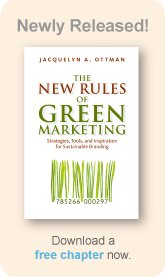Beyond Green: Winning Over Consumers by Putting Primary Benefits First
By Jacquie Ottman
Triple Pundit, April 2010
Greener products are now available within every industry and are a part of our everyday lives. But they didn’t get to be so ubiquitous just because they are better for the planet. Whether they were promoted as such or not, sales of green products grew because they were appreciated by a growing chorus of consumers for the value they provide—expressed as safety, comfort, good taste, or simply convenience.
Despite some lingering misperceptions that “green products don’t work as well” (leftover from the days when the natural laundry detergents left the clothes dingy), many of today’s green products actually work better than the alternatives they are designed to replace. Indeed, thanks to advances in technology and design, green is now becoming synonymous with quality, and can often command premiums because of it. Consider that a compact fluorescent light bulbs not only save money, they are more convenient since the bulbs don’t have to be replaced as often. “Organic” is the new gourmet. Drivers line up to buy a Prius with its quieter ride and fewer fill-ups.
Sensing the opportunity, many green products are now promoted with messages that lead “beyond green” and underscore such primary benefits as health, superior performance, good taste, cost effectiveness or convenience. Tide Cold Water for instance, underscores how much money consumers can save on energy bills. Similarly, the Energy Star label grew to be the most recognized eco-label because consumers made the connection between energy efficiency and saving money. AFM claims their Safecoat brand is ‘The only paint that is doctor recommended.’ The Toyota Prius was launched on the premise of a quieter ride, and later when gas prices spiked, stressed superior gas mileage.
This central message of primary benefits is critical to winning over the mainstream consumer, and it is associated with the potential to drive growth as well. Consider the success of Clorox GreenWorks, a line of natural cleaning products. The name “Green Works” supported by the well-established Clorox brand name assures consumers that the product does its job, while the natural ingredients provide proof of safety. Testament to its success, Clorox GreenWorks has helped to expand the market for all greener cleaning products, even the deep green ones.
Further evidence of the success of green products has been their resilience in the current recession. Everyone is pulling a little tighter on their money belts, yet sales and purchase intent of green products have remained strong because of the perceived value of many greener brands that lead with the messages of primary benefits. Moreover, many brands are not only competitively priced but saving consumers money, either in the short or long term.
Despite these successes, many deep green as well as mainstream marketers do not stress primary benefits, likely for two reasons. In the past, many of the products offered by deep green companies didn’t work as well as their “brown” counterparts, so messages to the consumer tended to be a simple: “our product does everything your current brand does but in a greener way”. Over time, mainstream companies entering the market espoused what I call the “planets, babies and daisies” approach (despite doing otherwise on established brands) mostly likely believing such imagery represented a price of entry into a market they didn’t understand and were not quite comfortable playing in. Now such brands as GreenWorks or Tide Coldwater are realizing that the name of the game is doing what they do naturally—leading with messages of primary benefits, while bringing in environmental messages as secondary.
This emphasis on primary benefits is sure to continue. This trend will bring more sophisticated attempts to integrate primary benefits with the environmental ones. An example of this is a current Lexus print advertisement: On the left side we see a stylish new car with the headline, “Indulge your senses,” and on the right side we see a leaf with the headline, “Respect the Planet.” The key takeaway delivered in a simple yet sophisticated way: we can have our cake and eat it, too.
Looking ahead, one day green will likely be so integrated into design and culture that we won’t have to trip over it when crafting marketing messages that resonate with consumers. For now, our challenge as green marketers is to articulate a distinctive expression of a consumer promise that can capitalize upon the inherent consumer benefits of a product’s environmental attributes to reinforce a brand’s overall positioning.



 ShareThis
ShareThis
Jacquelyn Ottman is president, J. Ottman Consulting, a green marketing consultancy that advises businesses on strategies for developing and marketing environmentally sustainable products and services. She is the author of three books on green marketing. Her latest book, The New Rules of Green Marketing, is due out in 2010.
Contact her by email
Follow her on Twitter
Connect to her on Linkedin
Read her blog
This article, which was first published on the Triple Pundit website, is excerpted from Jacquie's soon-to-be-published book, due out in 2010. Learn more and sign up to be notified of its release by clicking here. JC Darne contributed to this article.


